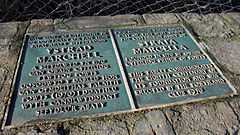Strata Marcella
| Strata Marcella Abbey | |
|---|---|
|
Commemoration of eighth century of Abbey's foundation | |
 Strata Marcella Abbey shown within Wales | |
| Basic information | |
| Location | Near Welshpool, Powys, Wales |
| Geographic coordinates | 52°41′10″N 3°06′33″W / 52.686119°N 3.109249°WCoordinates: 52°41′10″N 3°06′33″W / 52.686119°N 3.109249°W |
| Affiliation | Catholicism, Cistercians |
| Year consecrated | 1170 |
| Ecclesiastical or organizational status | Ruin. Abbey dissolved 1536, stone sold to build local churches. |
| Architectural description | |
| Architect(s) | unknown |
| Architectural type | Monastery |
| Architectural style | Cistercian |
| Length | 273 feet |
| Width | 96 feet |
The Abbey of Strata Marcella (Welsh: Abaty Ystrad Marchell) was a medieval Cistercian monastery situated at Ystrad Marchell (Strata Marcella being the Latinised form of the Welsh name) on the west bank of the River Severn near Welshpool, Powys, Wales.
Founding
It was founded in 1170 by Owain Cyfeiliog Prince of Powys, as a daughter house of the Abbey at Whitland. Within two years the Abbey had moved a short distance to the present site but excavations have found no evidence of any early structures before construction in stone started in 1190 so it is likely the earliest building were simple wooden structures. Building work continued until the early 13th century by which time Strata Marcella had become the largest Cistercian Abbey in Wales. Its nave was 200 feet long. It was monks from Strata Marcella who went to the Vale of Llangollen in 1200 to found the Abbey of Valle Crucis.
Welsh Independence
Strata Marcella was one of a number of Cistercian Abbeys founded by Welsh Princes which operated independently from the Norman-founded abbeys in England. As such they tended to support the Welsh Princes in their struggles against King Edward I of England and the Marcher Lords and because of this the abbey suffered much damage during the Welsh wars of independence. The abbot and monks were deemed to be working against English rule in Wales and in 1332, the local lord, John de Cherleton, ordered the eviction of all the Welsh monks and replaced them with English monks from Buildwas Abbey, Shropshire.
Owain Glyndŵr
During the Owain Glyndŵr rising at the beginning of the 15th century the buildings were heavily damaged and the monastery never completely recovered.
The Dissolution
The abbey was finally dissolved in 1536 at the dissolution of the monasteries in England and Wales. At that time there were only four monks at the abbey and the local lord, Lord Powis, had already purchased the site and had removed everything of value. The stone from the buildings was sold and used to build several local churches. Today the only visible remains are earthworks covering the remains of the church and cloister in a meadow beside the River Severn.
Excavations
The site was excavated in 1890 by Stephen W. Williams for the Powysland Club. The church had an overall length of 273 feet, with an aisled nave 201 feet long, transepts were 96 feet long with a short rectangular chancel, and a 30 ft square tower at the crossing. The long period of building was from c. 1190 till the early C14. There were buttresses, including clasping buttresses at the w end. The red sandstone columns of the ten-bay nave had the Early English pattern of shafts clustered on piers. Transitional and stiff-leaf capitals of great beauty reflect the sculptural developments between c. 1190 and c. 1210. Much of this space was occupied by two monks' choirs. It seems that the elaborate doorway to one of these may have been the original W doorway. Pier stones with 14th century wavy mouldings were found on the site of the tower. The cloister on the S was not excavated.[1] Finds, including 13th century tiles and stone fragments, are in the Powysland Museum, Welshpool.
Recently the site of Strata Marcella has been resurveyed by Clwyd-Powys Archaeological Trust and this has modified some of Stephen Williams' findings.
Literature
- R J Silvester, R Hankinson, W Owen and N Jones CPAT Report No 1090, Medieval and Early Post-Medieval Monastic and Ecclesiastical Sites in East and North-East Wales:The Scheduling Enhancement Programme April 2011.
- Scourfield R and Haslam R The Buildings of Wales: Powys; Montgomeryshire, Radnorshire and Breconshire" Yale University Press 2013.
- Thomas C. G. (ed), (1997) The charters of the Abbey of Ystrad Marchell. Aberystwyth : The National Library of Wales.
- Williams, D. H. (1992). An Appreciation of Stephen William Williams, Montgomeryshire Collections, Vol 80, 55–94
- Williams, D. H.(1995).The Exploration and Excavation of Cistercian Sites in Wales, Archaeologia Cambrensis, Vol 144, 1–25
- Williams, D. H. (2001). The Welsh Cistercians: written to commorate the centenary of the death of Stephen William Williams (1837–1899), (The father of Cistercian archaeology in Wales). Gracewing Publishing. . ISBN 978-0-85244-354-5.
- Williams S. (1891), (with Jones M C), Excavations on the site of Strata Marcella Abbey,Montgomeryshire Collections, Vol 25, .
References
- ↑ Williams S. (1891), (with Jones M C), Excavations on the site of Strata Marcella Abbey, Montgomeryshire Collections, Vol 25
External links
- Survey of site by CPAT 2012
- The Cistercians in Yorkshire
- 'House of Cistercian monks: Abbey of Buildwas', A History of the County of Shropshire: Volume 2 (1973), pp. 50-9.
